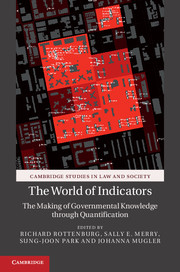Book contents
- Frontmatter
- Contents
- List of figures
- List of tables
- List of abbreviations
- List of contributors
- 1 A world of indicators: The making of governmental knowledge through quantification
- 2 The flight of the indicator
- 3 Narrating numbers
- 4 By their own account: (Quantitative) Accountability, Numerical Reflexivity and the National Prosecuting Authority in South Africa
- 5 Failure by the numbers? Settlement statistics as indicators of state performance in South African land restitution
- 6 Doing the transparent state: Open government data as performance indicators
- 7 Charting the road to eradication: Health facility data and malaria indicator generation in rural Tanzania
- 8 ‘Nobody is going to die’: An ethnography of hope, indicators and improvizations in HIV treatment programmes in Uganda
- 9 Financial indicators and the global financial crash
- 10 New global visions of microfinance: The construction of markets from indicators
- 11 Spirits of neoliberalism: ‘Competitiveness’ and ‘wellbeing’ indicators as rival orders of worth
- 12 Climate change vulnerability indicators: from noise to signal
- 13 Retroaction: how indicators feed back onto quantified actors
- Index
- Cambridge Studies in Law and Society
- References
10 - New global visions of microfinance: The construction of markets from indicators
Published online by Cambridge University Press: 05 October 2015
- Frontmatter
- Contents
- List of figures
- List of tables
- List of abbreviations
- List of contributors
- 1 A world of indicators: The making of governmental knowledge through quantification
- 2 The flight of the indicator
- 3 Narrating numbers
- 4 By their own account: (Quantitative) Accountability, Numerical Reflexivity and the National Prosecuting Authority in South Africa
- 5 Failure by the numbers? Settlement statistics as indicators of state performance in South African land restitution
- 6 Doing the transparent state: Open government data as performance indicators
- 7 Charting the road to eradication: Health facility data and malaria indicator generation in rural Tanzania
- 8 ‘Nobody is going to die’: An ethnography of hope, indicators and improvizations in HIV treatment programmes in Uganda
- 9 Financial indicators and the global financial crash
- 10 New global visions of microfinance: The construction of markets from indicators
- 11 Spirits of neoliberalism: ‘Competitiveness’ and ‘wellbeing’ indicators as rival orders of worth
- 12 Climate change vulnerability indicators: from noise to signal
- 13 Retroaction: how indicators feed back onto quantified actors
- Index
- Cambridge Studies in Law and Society
- References
Summary
Introduction
Many of the so-called developing and developed countries world-wide have a long history with microfinance, or the provision of small-size financial services to relatively poor people (Seibel 2005: 1). This chapter focuses on a particular set of changes in microfinance that have taken place across both developing and developed countries in the last few years: the formation of global market structures. More specifically, these structures are analysed here to illuminate the ways in which international standard-setting bodies attempt to construct global markets from indicators. If the visions of these groups of actors were to be achieved, the transformation of the microfinance sectors world-wide would be massive: countless small-size financial services to the poor all over the globe would be largely driven by a market that represents these local realities in a new information world that is highly self-contained. The complex and dynamic world of microfinance would be compressed into a few inches of computer screen. Based on these observable efforts of the standard-setters, this chapter makes the following case: a new global electronic market for microfinance is in the making and is the product of the long-term cultural and historical formation of ‘world society’. The present chapter discusses both the benefits and downsides of this trend.
‘World society’ is an umbrella term for various theoretical approaches (e.g. Heintz 1982; Meyer, Boli, Thomas and Ramirez 1997; Luhmann 1997; Heintz 2010). For instance, John W. Meyer and others contend that the term denotes a ‘culture’ that is ‘substantially organized on a world-wide basis’ and has ‘causal significance in its own right’, e.g. it cannot be reduced to local forces such as particular national or regional cultures (Meyer, Boli, Thomas and Ramirez 1997: 146–8). In addition to this important basic idea, Bettina Heintz’ approach (2010) is particularly apt to interpret the processes of change I wish to discuss here. She argues that globalization and the evolution of global markets largely depend on communication processes with the help of numbers, rather than other media such as spoken language, written text or images. More precisely, global markets would be ‘unthinkable’ without large-scale quantitative comparisons (Heintz 2010: 162–3, 174–6). To paraphrase Heintz’ reasoning further, this transformative power of quantitative comparisons is like a double-edged sword.
- Type
- Chapter
- Information
- The World of IndicatorsThe Making of Governmental Knowledge through Quantification, pp. 254 - 282Publisher: Cambridge University PressPrint publication year: 2015

